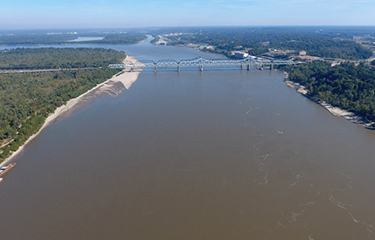As NOAA predicts larger than average Gulf dead zone, study reveals billions in damage to fish stocks

NOAA scientists announced on 3 June that the forecast for the Gulf of Mexico hypoxic area, more commonly referred to as the “dead zone,” will be larger than average in 2020.
The current forecast of the dead zone – an area of low to no oxygen that can kill fish and other marine life – predicts an area of roughly 6,700 square miles, which is larger than the recent average measured size of the dead zone of 5,387 square miles. For comparison, 6,700 square miles is roughly the size of the U.S. states of Rhode Island and Connecticut combined.
The phenomenon is caused by excess nutrient pollution from human activity in human and agricultural areas – mainly related to fertilizers. When those excess nutrients – mainly nitrogen – reach the Gulf or Mexico, it stimulates an overgrowth of algae. When those algae die, and decompose, they sink to the bottom of the ocean and deplete the oxygen in the area.
That depletion results in oxygen levels that “cannot support most marine life,” according to NOAA. Any fish that can’t leave the area are stressed or killed by the low oxygen, in a cycle that continues every summer.
“Not only does the dead zone hurt marine life, but it also harms commercial and recreational fisheries and the communities they support,” said Nicole LeBoeuf, acting director of NOAA’s National Ocean Service. “The annual dead zone makes large areas unavailable for species that depend on them for their survival and places continued strain on the region’s living resources and coastal economies.”
The announcement of the dead zone prediction comes soon after a new report released by the Union of Concerned Scientists (UCS), which looked into the economic damage that the dead zone causes to Gulf of Mexico fisheries each year.
That study indicates that the dead zone has caused, on average, up to USD 2.4 billion (EUR 2.1 billion) in damages to gulf fish stocks, and their habitat, every year for more than 30 years.
“Gulf Coast communities know that the dead zone impacts their livelihoods, but research has never put a dollar value on its damage to the fishing industry,” said Rebecca Boehm, an economist at UCS and author of the report. “This study quantifies both the amount of nitrogen flowing to the Gulf from farms upstream, and the toll it is taking economically on the foundation of the Gulf fishing industry.”
The UCS report found that cheap, nitrogen-based fertilizers, coupled with increasingly intense rainfall, have led to flushes of fertilizer into streams and rivers that eventually end at the Gulf of Mexico.
NOAA also concurred that the annual dead zone is caused by nutrient pollution.
"The annually recurring Gulf of Mexico hypoxic zone is primarily caused by excess nutrient pollution occurring throughout the Mississippi River watershed," said Don Cline, associate director for the USGS Water Resources Mission Area, in the NOAA release. “Information on where these sources contribute nutrients across the watershed can help guide management approaches in the Gulf.”
Rainfall in recent years has been unprecedented in the Lower Mississippi Valley, with the amount of freshwater alone devastating oyster, shrimp, and other fisheries. In April, the Bonnet Carre Spillway – a flood control mechanism for the area – was opened for an unprecedented third straight year.
“A major factor contributing to this year’s above-average hypoxic zone are the high river flows and nutrient loads delivered to the Gulf this spring, primarily from the Mississippi and Atchafalaya rivers. In May 2020, discharge in the Mississippi and Atchafalaya rivers was about 30 percent above the long-term average between 1980 and 2019,” NOAA stated.
The dead zone creates a huge problem for Gulf fishermen, according to the UCS.
“The persistently large dead zone can lead to reduced catch and increased fuel demands for Gulf fishers, who must travel further out for their hauls,” it said.
The latest, larger-than-average dead zone is also coming at a time when many fishermen in the region are grappling with the ongoing impacts of the COVID-19 pandemic.
“Lots of factors cause shrimpers to lose business, but COVID-19 may completely shut many of us down,” said John Williams, executive director of the Southern Shrimp Alliance and a Gulf shrimper for more than three decades. “Hopefully the industry will get through this health crisis, and in the meantime, we need to address what we can to ensure the Gulf’s long-term sustainability. As long as the dead zone persists, our way of life, and the rich seafood culture of the region is in danger.”
UCS said Midwest farmers can help the situation by “cultivating healthy living soil that minimizes erosion and nutrient runoff, increases water-holding and draining capacity, and reduces the need for fertilizers.”
“Midwest farmers and Gulf fishers are in this together,” Boehm said. “Nitrogen pollution and unhealthy soil hurt the ecosystem upon which the Gulf fishing economy is based. With technical and financial support, farmers can work the land to increase their own resilience, while also protecting the vital Gulf fishing culture and economy downstream.”
Photo courtesy of NOAA






Share